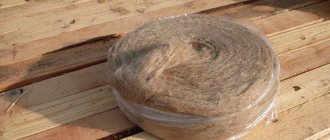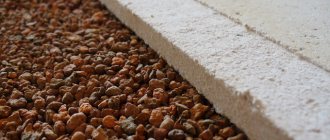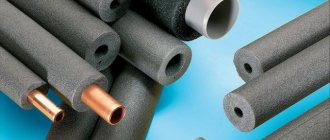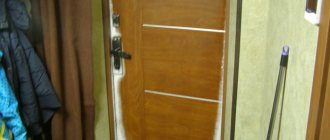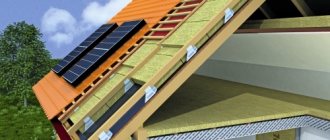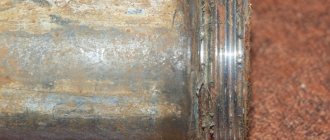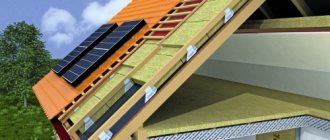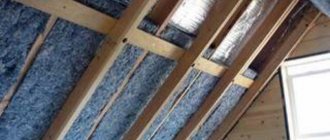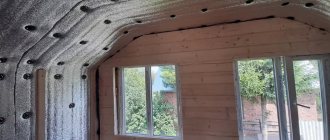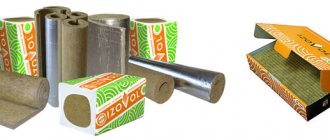To insulate the premises of construction sites, pipelines, ventilation ducts of engineering communications, both flammable and non-flammable insulation materials of various types are used.
The definition of non-flammable fire-resistant insulation is given by GOST 30244-94, which indicates that such a material, when exposed to an ignition source, burns with an open fire for no more than 10 s, and when tested in a laboratory oven loses no more than 50% of its mass, creating a temperature increase in it of no more than 50 ℃.
All insulation materials that do not satisfy at least one of the listed conditions are classified as flammable, non-fire-resistant materials.
Types of Fire Resistant Thermal Insulation Products
Mineral wool material for thermal insulation: pros and cons
The most famous non-flammable insulation is based on mineral wool. Sold in rolls and in the form of mats. It differs in terms of density and thickness. A distinctive feature of the material is that it maintains its performance even when heated to 400 degrees Celsius without the risk of damage.
This resistance to high temperatures is explained simply - mineral wool is obtained by melting durable rocks:
- basalt;
- dolomite;
- limestone.
Additionally, metallurgical slag is included in the composition of wool. The material has both advantages and disadvantages. Among the disadvantages, it should be noted the fairly high level of acidity included in the slag wool and the instability of thermal insulation to moisture. The undoubted advantages are resistance to high temperatures and a wide range of applications, from wall insulation to roof insulation.
Classification
Non-flammable fire-resistant insulation is often classified according to its state of aggregation, appearance, internal structure, depending on which it can be:
- Frame , including multilayer, reinforced with non-combustible materials, often used as elements of structural fire protection of load-bearing metal structures of construction projects.
- Rolled , which allows you to wrap it around elements of building structures of various shapes and cross-sections, as well as sections of pipelines and ventilation ducts that need to be protected from freezing and possible exposure to fire in the event of a fire.
- Slab , as well as in the form of separate heat-insulating mats, specially developed by designers and manufacturers of standard sizes, which facilitates their installation and installation inside building structures, for example, partitions between rooms.
- Loose , including artificially expanded, cellular, which significantly increases its thermal insulation properties.
- Liquid foaming material that hardens during polymerization and drying after application to building structures, sections of pipeline networks, ventilation systems of protection facilities, most often called fire-resistant foam.
The choice of one or another class of non-combustible, fire-resistant insulation is determined both by design solutions and experience of use in civil and industrial construction during the construction and repair of various objects.
| Slab fire-resistant insulation | Foil fire-resistant insulation for chimneys of stove pipes |
| Stitched foil fire-resistant insulation | Fire resistant mineral wool |
Foam glass - what is the difference and how is it used
An equally worthy option is non-flammable thermal insulation based on foam glass (cellular glass). Visually, the material resembles frozen soap foam with a special porous surface.
It is produced by sintering glass chips with a gas-forming agent, usually coal.
The result is durable, non-flammable insulation, which even under the influence of record high temperatures only melts without releasing toxins.
Compared to the main advantages of the material, the disadvantages seem insignificant. These include instability to mechanical damage and high weight.
It is advisable to use foam glass for insulating basement walls that are not subject to mechanical damage. The service life of the material declared by the manufacturer is more than one hundred years.
Criterias of choice
- achieve high thermal efficiency by choosing insulation with a low thermal conductivity coefficient. In addition, we must not forget that when insulating a room, only 20-25% of heat loss occurs on the walls. In this regard, the issue of insulation should be approached comprehensively; the maximum effect can be achieved only by creating an absolutely airtight structure.
- An important criterion is the cost of the product. It should be remembered that high-quality insulation cannot be cheap. An unjustified price reduction means a violation of the insulation manufacturing technology, which directly affects its technical features.
- When purchasing modern mineral wool insulation, you should pay attention to the location of the fibers . Preference should be given to products with a chaotic arrangement. Unlike analogues with horizontally or vertically oriented fibers, they are characterized by higher thermal and sound insulation rates.
- Fire-resistant facade material, in addition to low thermal conductivity , must demonstrate good moisture strength and biostability. For finishing the inside of a house, environmental safety characteristics and the absence of toxic substances in its composition are important.
- If mineral wool insulation is not subject to loads (for example, it is laid on a frame or between load-bearing structures), you can choose a less dense (up to 90 kg/cubic m) option. It's cheaper. If pressure is applied to the material, then the indicators of strength and tensile strength and compression become important.
These qualities are demonstrated by denser (semi-rigid and hard-hard) analogues, which are more expensive.
Basalt fiber - how it works and what are the disadvantages
Another mineral wool derivative is basalt fiber. The material is obtained using pure basalt crushed stone without impurities as a base. Due to its increased resistance to fire and high temperatures, the material is used in the field of thermal insulation of walls in baths and saunas, as well as other rooms with a high risk of ignition.
Compared to all of the above materials, basalt fiber is especially expensive, which is considered its main disadvantage.
Where is it used?
Various types of non-combustible insulation are used in the construction industry:
- for facade systems;
- when installing roofs and ceilings;
- for exterior decoration of house walls;
- when installing chimneys and stoves; in the construction of a bathhouse;
- for insulating pipes in various communication networks.
The climate in most regions of our country makes the selection of heat-insulating products with fire protection an urgent problem.
Glass wool - material features
Based on ordinary mineral wool, fiberglass is also used for thermal insulation of walls. The material is obtained from broken glass using the spunbonding method by drawing when it comes to fine fiber and by the blowing method when it is necessary to obtain a coarser fiber.
Thermal insulation is sold in the form of rolls and slabs. The latter are more often used for the walls of ventilated facades, as well as roofs, attics and basements. Rolled thermal insulation material is suitable for insulating all horizontal surfaces, including floors.
The main disadvantage of fiberglass wool is the high risk of skin irritation during work.
In what cases is it necessary to use non-combustible insulation?
When building a private house, the owner independently chooses thermal insulation materials based on his capabilities and needs.
Building codes require the use of non-combustible insulation only when constructing the following objects:
- saunas, baths;
- car maintenance and fuel stations;
- underground parking lots, garages;
- premises equipped with stove heating;
- high-rise residential buildings;
- children's and medical institutions;
- buildings that are regularly visited by large numbers of people.
The use of fire-resistant materials is also necessary in rooms where flammable products are stored.
Expanded vermiculite - subtleties of application
To insulate walls on the construction and finishing materials market, you can also choose the bulk material obtained by firing natural hydromica - vermiculite. This is granular thermal insulation with a special scaly structure, which exhibits increased resistance to microorganisms.
The material is actively used in the field of low-rise construction, for thermal insulation of attics and external walls.
Vermiculite is not resistant to moisture and this is its main disadvantage. When using material for thermal insulation of walls, it is necessary to consider additional waterproofing.
Oxygen index
The oxygen index is a fire safety characteristic of a material, which shows the minimum amount of oxygen per unit volume of insulation. According to the oxygen index, there are several flammability thresholds:
- 40% - composite polymers;
- 31% - fibrous and cellular non-flammable insulation;
- 20% - materials that burn well in air.
This is one of the parameters showing the degree of fire resistance of the insulation. The characteristic shows how much oxygen is contained in a unit volume of the insulator. The following boundaries are defined for the index:
- composite polymers – up to 40%;
- non-flammable heat insulators with a fibrous and cellular structure – up to 31;
- burning insulation - up to 20.
Perlite: how it is obtained and characteristics
A good choice of thermal insulation material is obsidian hydroxide granules, also known as perlite. Its advantages include light weight and excellent thermal insulation properties. The material is suitable for insulating residential and commercial buildings, both for walls instead of ordinary mineral wool, and for sloping roofs. The material is ideally used to fill voids in wall masonry.
The disadvantage of perlite is its poor resistance to mechanical stress. Even a slight load can lead to destruction of the material, so you need to work with it especially carefully, observing safety precautions during transportation. A significant disadvantage is the ability of the wall insulation material to absorb moisture.
Porous insulators with fire resistance parameters
This is a fireproof building insulation of the latest generation. Mostly, the materials are made from natural raw materials: glass, coal and other components. Up to 80% of them consist of voids. Insulation materials do not support combustion, do not emit toxic substances, are easy to cut, and are suitable for insulating any external and internal structures, including chimneys.
Advantages:
- high thermal insulation characteristics;
- fire resistance;
- low price;
- environmental Safety.
This building material has no deficiencies identified.
Foam glass production formats
Choosing fire-resistant insulation is a pressing task for many potential owners of country houses. Watch the tests of thermal insulation materials for non-flammability in this video:
Marks and brands: which thermal insulation to choose
Mineral wool, glass wool, perlite and other materials actively used for thermal insulation are available on the market in a wide range under different brands of manufacturers from the CIS countries and Europe. Below are the most famous of them:
- Rockwool;
- Isover;
- Ursa;
- Rocklight.
Rockwool (Rockwool) specializes in the production of basalt thermal insulation using special Flexi technology. On the market, the company sells hydrophobic slabs based on mineral wool. The Light Butts series with products 50/100 mm thick is especially in demand for insulating not only walls, but also horizontal surfaces.
To insulate the premises of baths and saunas, it is worth purchasing thermal insulation materials from Isover with a special layer of foil. The products are elastic, lightweight, easy to install and are not damaged during transportation.
When the task is to thermally insulate pitched roofs, Ursa Geo materials with excellent noise insulation properties and a high flammability class are used. The products are produced using Ursa Spannfilz technology, which makes it possible to increase their elasticity and extend their service life.
An excellent option for universal basalt-based insulation for walls and roofs is Rocklight. The material is produced in rolls with standard parameters: 600 mm wide and 1200 m long.
In conclusion, it remains to be noted that following the recommendations of experts, mineral wool insulation made from basalt raw materials with a density calculation based on the area of application is best suited for thermal insulation of walls inside a house, foundations, external walls and roofs.
A few recommendations
When choosing fireproof insulation, first of all pay attention to the place of its application. For insulating foundations, non-mineral materials such as foam glass, polystyrene foam or polyurethane foam are more suitable.
When insulating roofs and facades of buildings, preference is given to basalt wool with a density of about 140 kg/m3.
The environmental friendliness of the material is also taken into account. If the house is still under construction, it is better to insulate the external walls with expanded clay, perlite or vermiculite. In old buildings this is not always possible, so glass wool or spray foam is used.
Properly selected insulation will protect the structure from destruction and significantly reduce the cost of heating the house in the winter months. Don't go after cheap prices. It is better to purchase high-quality materials from large companies with a good reputation. In this case, they will last for several decades and will fully cope with their functions.
Types of finishing raw materials
When insulating fireplaces, special materials are used, mainly stone wool slabs, such as:
- Fire Batts (Rockwool), price for 1 package (8 pieces, size 1000x600x30 mm) - about 3 thousand rubles;
- PS17 (Ragos), price of 1 package (7 pcs. 1200x600x30 mm) - about 2 thousand rubles;
- “TECHNO T 80” (“TechnoNIKOL”), price of 1 package (6 pieces measuring 1200x600x50 mm) - about 3400 rubles.
The main feature of such materials is the operating temperature range, which varies from 170 to 800 degrees. Such plates are ordinary, with an index for fire resistance and with reinforced heat-resistant foil glued to one side (with a special heat-resistant glue, the temperature threshold of which is 20–30% higher than that of the product itself).
If you choose the finishing material wisely, when arranging the stove, follow the advice of both fireplace manufacturers and manufacturers of insulating materials; during operation, observe the usual precautions and safety measures (do not leave a functioning fireplace unattended, do not leave flammable materials near it or near it). products and objects), then you will enjoy the warmth and fire of the fireplace for a long time, without putting your home or yourself at risk
Let's summarize
The fire safety of the building depends on how good the insulation is. It is better to choose products from well-known brands; they exactly correspond to the declared characteristics. Thermal insulators of such brands as Rockwool, Rocklight, Technonikol, Isover and Ursa are in demand. These modifications can be purchased at low prices in the network construction stores “Leroy Merlin”, “Your House” and other retailers.
Tags: fireproof, wall, insulation
« Previous entry
